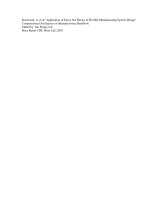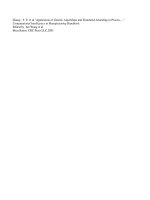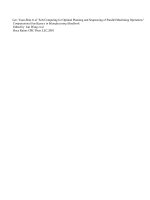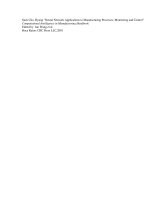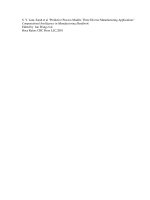Computational Intelligence In Manufacturing Handbook P11
Bạn đang xem bản rút gọn của tài liệu. Xem và tải ngay bản đầy đủ của tài liệu tại đây (296.51 KB, 13 trang )
S. Y. Lam, Sarah et al "Predictive Process Models: Three Diverse Manufacturing Applications"
Computational Intelligence in Manufacturing Handbook
Edited by Jun Wang et al
Boca Raton: CRC Press LLC,2001
©2001 CRC Press LLC
11
Neural Network
Predictive Process
Models: Three Diverse
Manufacturing
Applications
11.1 Introduction to Neural Network Predictive
Process Models
11.2 Ceramic Slip Casting Application
11.3 Abrasive Flow Machining Application
11.4 Chemical Oxidation Application
11.5 Concluding Remarks
11.1 Introduction to Neural Network Predictive Process Models
In a broad sense, predictive models describe the functional relationship between input and output
variables of a data set. When dealing with real-world manufacturing applications, it is usually not an
easy task to precisely define the set of input variables that potentially affect the output variables for a
particular process. Oftentimes, this is further complicated by the existence of interactions between the
variables. Even if these variables can be identified, finding an analytical expression of the relationship
may not always be possible. The process of selecting the analytical expression and estimating the param-
eters of the selected expression could be very time-consuming.
Neural networks, a field that was introduced approximately 50 years ago, have been getting more
attention over the past 15 years. There are a number of survey papers that summarize some of the
applications of neural networks. Udo [1992] surveys within the manufacturing domain, which covers
resource allocation, scheduling, process control, robotic control, and quality control. Zhang and Huang
[1995] provide a good overview of many manufacturing applications. Hussain [1999] discusses a variety
of applications in chemical process control. One of the advantages of neural network modeling is its
ability to learn relationships through the data itself rather than assuming the functional form of the
relationship. A neural network is known as a universal approximator [Hornik et al., 1989; Funahashi,
1989]. It can model any relationship to any degree of accuracy given that there are sufficient data for
modeling. It can tolerate noisy and incomplete data representations. Moreover, it can dynamically adjust
to new process conditions by continuous training. Through an iterative learning process, a neural network
extracts information from the training set and stores the information in its weight connections. After a
Sarah S. Y. Lam
State University of New York
at Binghamton
Alice E. Smith
Auburn University
©2001 CRC Press LLC
network is trained, it can then be used to provide predictions for new inputs. But how good is the network
when it is used to make predictions on data that are not used to train the network?
Being an empirical modeling technique, validating the network is at least as important as constructing
the network. Theoretically speaking, an infinite number of data points should be used to validate and
evaluate the performance of a network. However, this is not feasible in practice. In order to maximally
leverage the available data, resampling methods such as
cross validation
and
group cross validation
can be
used to validate the network [Twomey et al., 1995; Lam et al., 2000; Lam and Smith, 1998; Coit et al.,
1998]. These validation methods are more appealing than the traditional
data splitting
approach, espe-
cially when the data are sparse. They allow the construction of the network based upon the entire data
set but also allow the evaluation of the network using all the data that are available [Efron, 1982; Wolpert,
1993]. Hence, these methods ensure the extraction of as much information from the available data as
possible for developing an
application network,
ensuring the best possible prediction performance. The
trade-off of using these resampling methods is the incurred computational expense of developing multiple
validation networks
in order to infer the performance of the application network [Twomey and Smith,
1998].
This chapter discusses some applications where neural networks have been used successfully as pre-
dictive process models. These applications have relatively sparse data sets; therefore, resampling methods
are used to validate the application networks. More specifically, the manufacturing processes covered
include: (1) a ceramic slip casting process, (2) an abrasive flow machining process, and (3) a chemical
oxidation process. These examples are real-world engineering problems where designed experiments were
conducted for the first and the last examples to supplement production data.
11.2 Ceramic Slip Casting Application
The slip-casting process is used to produce ceramic ware in many complicated shapes — such as bowls,
statues, and sinks — that cannot be achieved through conventional pressing. However, this flexibility
does not come without a price. It is generally more difficult to achieve a desired level of product quality
in the presence of many controllable and uncontrollable process factors. Basically, the manufacturing of
ceramic ware consists of the following steps:
1. Preparing the liquid clay (a slurry, or slip)
2. Casting the slip in a plaster mold for a specified duration
3. Removing the mold
4. Air drying the cast piece
5. Spray gazing the dried piece
6. Firing the gazed piece in a kiln
7. Inspecting the finished product.
The slip is prepared by mixing clay powder with a suspending liquid. Deflocculants are added to the
slurry to provide stability and density, and binders are added to ensure that the resulting cast is strong
enough to be handled. This slip is then poured into a plaster mold and stays there for a specified time
period in order to form a solid product. The liquid in the slip is absorbed into the mold through capillary
action, resulting in a solid cast inside the mold. When it is estimated (by the slip cast operators) that the
cast has reached the desired wall thickness, it is then removed from the mold, air dried, glazed, and fired
to produce a finished product [Adams, 1988].
Slip casting largely determines the quality of the final product. If the slip casting process takes too
long, the cast will be too dry and may result in cracks. On the other hand, if it does not allow sufficient
time period for the slip to cast, the cast piece will be too wet and may result in instabilities. These defects
are manifest in the subsequent steps of the manufacturing process. Defects that are found before the
ware is fired can often be repaired. For defects that cannot be repaired, the material can be recovered,
but the considerable labor and overhead are still irretrievably lost. Most defects that are found after
firing result in a complete loss of the defective piece. The proportion of defective pieces due to casting
©2001 CRC Press LLC
imperfections can approach as much as 30%. This figure obviously poses a significant problem that
affects the efficiency and profitability of these manufacturing firms.
The primary causal factor for cast fractures and/or deformities is the distribution of moisture content
inside the cast before firing. When the moisture differential, or
moisture
gradient,
inside the wall of the
cast is too steep, it results in stress differences. It is the stress differences that cause the piece to deform
and eventually fracture. In order to minimize the possibility of fractures or deformities, the moisture
content should be as uniform as possible. In other words, the moisture gradient should be close to zero
in order to have a good cast. Another important measure is
cast rate
, which is actually the thickness of
the cast (in inches) achieved during a set time in the mold. A larger cast rate is more desirable because
it indicates an increase in production efficiency.
The quality of the cast (moisture gradient) and the cast rate depend on the slip conditions, the ambient
conditions in the plant, and the plaster mold conditions. As the age of the mold increases, the capillary
action of the mold degrades, which causes an increase in the required casting time. Ambient conditions
also have a significant effect on casting time. Molds that are cast under hot, dry conditions (i.e., near a
kiln) require less casting time than molds cast under cooler, wetter conditions (i.e., near the building
exterior). The variance of ambient conditions across the plant can be a significant problem in ceramic
casting facilities. Two ambient variables (the plant temperature and humidity), ten slip property variables,
and the cast time are identified as significant factors for determining the cast quality and the cast efficiency.
These variables are summarized in Table 11.1.
11.2.1 Neural Network Modeling for Slip Casting Process
Two separate networks were developed, one to predict the moisture gradient and the other to predict
the cast rate. The dual models’ approach was motivated partly because of the uneven distribution of the
data. However, the main motivation behind this was the undefined underlying relationship between the
process variables and the unknown interactive behavior of the variables.
Two separate data sets (consisting of production data supplemented by experimental data) were
collected and obtained by the plant technicians. There were 367 observations for the moisture gradient
model and 952 observations for the cast rate model. Both of these models have the same set of input
variables as illustrated in Table 11.1. The network architectures, training parameters, and stopping criteria
were finalized through experimentation and examination of preliminary networks. An ordinary back-
propagation algorithm was used because of its simplicity and its documented ability as a continuous
function approximator [Hornik et al., 1989; Funahashi, 1989]. The final application network architecture
TABLE 11.1
Slip Casting Process Parameters
Input Parameter Definition
1 Plant temperature (°F) The temperature of the plant.
2 Relative humidity (%) The humidity level of the plant.
3 Cast time The time duration that the liquid slip is left in the mold before
draining.
4 Sulfate (SO
4
) content The proportion of soluble sulfates in the slip.
5 Brookfield–10 RPM Viscosity of the slip at 10 revolutions per minute.
6 Brookfield–100 RPM Viscosity of the slip at 100 revolutions per minute.
7 Initial reading Initial viscosity (taken at 3 1/2 minutes).
8 Build up Change in viscosity from initial reading (taken after 18 minutes)
9 20 minute gelation Thixotropy (viscosity vs. time).
10 Filtrate rate The rate at which the slip filtrates.
11 Slip cake weight Approximation of the cast rate without considering a mold.
12 Cake weight water retention Moisture content of the cake. See slip cake weight.
13 Slip temperature The temperature of the slip.
Source:
Lam, S. S. Y., Petri, K. L. and Smith, A. E., Prediction and Optimization of a Ceramic Casting Process
Using A Hierarchical System of Neural Networks and Fuzzy Logic,
IIE Transactions,
32(1), 83–91, 2000.
©2001 CRC Press LLC
for the moisture gradient model had 13 inputs, two hidden layers with 27 hidden units in each layer,
and a single output. The output unit represents the moisture gradient of the cast piece. Similarly, the
architecture for cast rate model had the same input variables, two hidden layers with 11 hidden units in
each layer, and a single output that represents the cast rate of the slip casting process.
In order to assure that the plant engineers and supervisors have faith in the models, and that the neural
network predictions were accurate, a five-fold group cross-validation method was used to validate the two
application networks. This resampling method allows all the data to be used for both construction and
validation of the neural network prediction models. This approach divided the available data into five
mutually exclusive groups. Five validation networks were constructed, using the same parameters as the
application network described above, where each used four groups of data to train the validation network
and test it on the hold-back group. Each validation network had a different hold-back group as a test set.
The errors of the five tests provide an estimate of the generalization ability of the application network.
Tables 11.2 and 11.3 summarize the mean absolute errors (MAE) and root mean squared errors (RMSE)
of the validation and application networks for the moisture gradient network and the cast rate network.
Typically, the error measures on the validation networks are not as good as those on the application
network. This observation is obvious because the errors of the application network were calculated by
resubstituting the training data back into the model, whereas the errors of the validation networks were
obtained using the five hold-back test sets.
Figure 11.1 shows typical cross-validation network predictions for the moisture gradient network, and
Figure 11.2 shows a similar graph for the cast rate network. By comparing these figures, it appears that
the cast rate network performs better than the moisture gradient network. The predictions of the cast
rate application network are accurate over the entire range of the process variables. On the other hand,
the predictions of the moisture gradient network are fairly accurate, except for large values of the target.
This can be explained by the skewed distribution of the data (367 observations) where almost 90% percent
of the data have values of moisture gradient less than 0.01 (see Figure 11.3). Also, there was considerable
human error possible in the moisture gradient measurement. However, despite the imperfection of the
performance of the moisture gradient network, it provides adequate precision for use in the manufac-
turing plant.
11.3 Abrasive Flow Machining Application
Abrasive flow machining (AFM) was originally developed for deburring aircraft valve bodies. It has many
applications in the aerospace, automotive, electronic, and die-making industries. The product spectrum
includes turbine engines, fuel injector nozzles, combustion liners, and aluminum extrusion dies. It is a special
finishing process that is used to deburr, polish, or radius surfaces of critical components. However, it is not
a mass material removal process. AFM removes small quantities of material by a viscous, abrasive-laden,
semi-solid grinding media flowing under pressure through or across a workpiece. The AFM process acts in
a manner similar to grinding or lapping where the extruded abrasive media gently hones edges and surfaces.
The abrasive action occurs only in areas where the media flow is restricted. The passageways that have the
greatest restriction will experience the largest grinding forces and the highest deburring ability.
TABLE 11.2
MAE and RMSE for the Moisture Gradient Network
Network MAE RMSE
Application network 0.0025 0.0045
Validation networks 0.0036 0.0061
TABLE 11.3
MAE and RMSE for the Cast Rate Network
Network MAE RMSE
Application network 0.0156 0.0207
Validation networks 0.0167 0.0243

